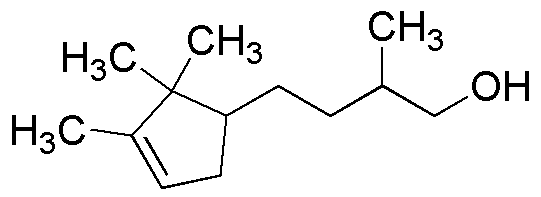2-Methyl-4-(2,2,3-trimethyl-3-cyclopenten-1-yl)-1-butanol is widely utilized in research focused on:
- Fragrance Industry: This compound is used as a key ingredient in perfumes and fragrances, providing a unique scent profile that enhances product appeal.
- Flavoring Agents: It serves as a flavoring agent in food and beverages, contributing to complex flavor notes that improve consumer satisfaction.
- Cosmetic Formulations: The chemical is incorporated into cosmetic products for its pleasant aroma and potential skin-conditioning properties, making it a popular choice among formulators.
- Pharmaceuticals: It is explored in drug development for its potential therapeutic effects, particularly in formulations aimed at improving patient compliance through taste masking.
- Aromatherapy Products: The compound is used in essential oils and aromatherapy blends, promoting relaxation and well-being through its aromatic properties.
General Information
Properties
Safety and Regulations
Applications
2-Methyl-4-(2,2,3-trimethyl-3-cyclopenten-1-yl)-1-butanol is widely utilized in research focused on:
- Fragrance Industry: This compound is used as a key ingredient in perfumes and fragrances, providing a unique scent profile that enhances product appeal.
- Flavoring Agents: It serves as a flavoring agent in food and beverages, contributing to complex flavor notes that improve consumer satisfaction.
- Cosmetic Formulations: The chemical is incorporated into cosmetic products for its pleasant aroma and potential skin-conditioning properties, making it a popular choice among formulators.
- Pharmaceuticals: It is explored in drug development for its potential therapeutic effects, particularly in formulations aimed at improving patient compliance through taste masking.
- Aromatherapy Products: The compound is used in essential oils and aromatherapy blends, promoting relaxation and well-being through its aromatic properties.
Documents
Safety Data Sheets (SDS)
The SDS provides comprehensive safety information on handling, storage, and disposal of the product.
Product Specification (PS)
The PS provides a comprehensive breakdown of the product’s properties, including chemical composition, physical state, purity, and storage requirements. It also details acceptable quality ranges and the product's intended applications.
Certificates of Analysis (COA)
Search for Certificates of Analysis (COA) by entering the products Lot Number. Lot and Batch Numbers can be found on a product’s label following the words ‘Lot’ or ‘Batch’.
*Catalog Number
*Lot Number
Certificates Of Origin (COO)
This COO confirms the country where the product was manufactured, and also details the materials and components used in it and whether it is derived from natural, synthetic, or other specific sources. This certificate may be required for customs, trade, and regulatory compliance.
*Catalog Number
*Lot Number
Safety Data Sheets (SDS)
The SDS provides comprehensive safety information on handling, storage, and disposal of the product.
DownloadProduct Specification (PS)
The PS provides a comprehensive breakdown of the product’s properties, including chemical composition, physical state, purity, and storage requirements. It also details acceptable quality ranges and the product's intended applications.
DownloadCertificates of Analysis (COA)
Search for Certificates of Analysis (COA) by entering the products Lot Number. Lot and Batch Numbers can be found on a product’s label following the words ‘Lot’ or ‘Batch’.
*Catalog Number
*Lot Number
Certificates Of Origin (COO)
This COO confirms the country where the product was manufactured, and also details the materials and components used in it and whether it is derived from natural, synthetic, or other specific sources. This certificate may be required for customs, trade, and regulatory compliance.

